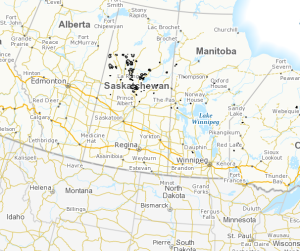The smoke and haze residents around Wright County, MN are seeing Monday, July 6 aren’t from a fire in a local field. They’re from thousands of miles away, in Saskatchewan, Canada.
Northern air is making its way down through the Dakotas and into Minnesota Monday, prompting the Minnesota Pollution Control Agency to issue a statewide Air Advisory. More on that advisory can be found below.
The issue is literally hundreds of thousands of acres of land burning in Canada. Dry, even drought conditions have made wooded areas kindling for some of the largest fires in Western Canada’s history, with firefighters battling more than 10 times the normal acreage of fires for the average forest fire season over the past few weeks.
More than 13,000 people have been moved from their homes in just the last weekend, and not a lot of relief looks to be in sight. A high pressure dome is building over the area, keeping the mountains dry. Even northern Idaho is seeing some effects, with fires burning north of the resort town of Sandpoint.

A screenshot of a map indicated where fires are burning in the Canadian provinces. More than 740,000 acres are burning in Saskatchewan, alone. (Source: Canadian Government)
In Minnesota, the smoke hampered the Fourth of July weekend, creating a haze on both Friday and, particularly, Saturday. Warm, moist air from the south pushed out the smoke on Sunday, but storms moved through Sunday night and Monday morning to move that air out, clearing the way for the Canadian air.
Here’s the MPCA update:
The Minnesota Pollution Control Agency (MPCA) has issued an air pollution health alert for the northern two-thirds of Minnesota due to smoke blowing in from forest fires in Canada. While air quality briefly improved following rain showers on Sunday and Monday, heavy smoke is returning to Minnesota behind the storm system. As of 9:00 a.m. Monday, air quality across the northern two-thirds of Minnesota had reached unhealthy levels. Air quality is expected to remain poor throughout the day on Monday.
While air quality is currently good across southern Minnesota, including the Twin Cities, smoke may return to the area later today. For current air quality conditions visit the Air Quality Index page.
The MPCA issues an air pollution health alert when air quality conditions reach unhealthy for sensitive group levels, or an AQI greater than 101.
At-risk populations: Fine particle pollution has reached a level considered unhealthy for everyone. Everyone may begin to experience health effects and members of sensitive populations may experience more serious health effects. Populations sensitive to fine particles include those with preexisting cardiovascular or respiratory disease, the elderly, children, and individuals who participate in activities requiring extended or heavy exertion, both indoors and outdoors. Members of these groups are encouraged to postpone or reduce vigorous activity and minimize exposure to local sources of air pollution (i.e.,heavy duty vehicle traffic, wood fires and candles). Even individuals who are otherwise healthy may experience health effects when pollution levels increase.
Health impacts: Exposure to high levels of fine particles has been linked with both respiratory and cardiovascular health effects. Fine particles may exacerbate pre-existing health conditions and may cause individuals to experience chest pain, shortness of breath, wheezing, coughing or fatigue. If you experience these symptoms, contact your physician.
Pollution-reduction tips: Fine particles are produced from combustion activities, which include fossil fuel-based energy generation, motor vehicle exhaust, gasoline-powered yard and lawn equipment, and wood burning. Conserving energy, buying clean renewable power, and utilizing alternate means of transportation, such as mass transit, will all reduce your daily contribution to air pollution. During air quality alerts, residents are particularly encouraged to postpone or reduce vehicle trips and engine idling, the use of gasoline-powered equipment, and burning wood.